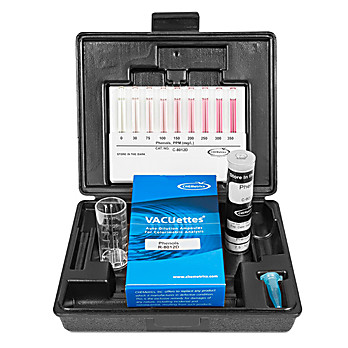Phenols VACUettes Refill, 4-Aminoantipyrine, Range: 0-120 & 0-1,400 ppm, Each

|
|
Details:
Phenol (hydroxybenzene) is the simplest of a group of similar organic chemicals, which includes cresols, xylenols, and catechols. Phenol itself is a common ingredient of disinfectants. In drinking water, low-level phenolic concentrations impart a foul taste and odor, especially upon chlorination. High phenol concentrations can indicate contamination from industrial effluents or waste discharge.The 4-Aminoantipyrine MethodReferences: APHA Standard Methods, 14th ed., Method 510 C (1975). ASTM D 1783-01, Phenolic Compounds in Water, Test Method B. USEPA Methods for Chemical Analysis of Water and Wastes, Method 420.1 (1983).CHEMetrics' phenols kits employ the well-established 4-aminoantipyrine (4-AAP) method. Phenolic compounds react with 4-AAP in alkaline solution in the presence of ferricyanide to produce a red reaction product. Phenol, meta-, and ortho-substituted phenols, and some para-substituted phenols, under proper pH conditions, are detected with this method. The method is applicable to the monitoring of phenolic compounds in wastewater. Results are expressed as ppm (mg/L) phenol.
Additional Information
| SKU | 5301323 |
|---|---|
| UOM | Each |
| UNSPSC | 41116105 |
| Manufacturer Part Number | R-8012B |

